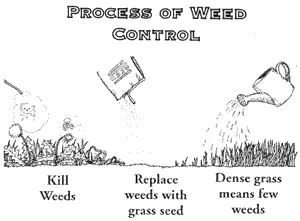SOMETIMES THE PROBLEMS WITH WEEDS ARE AS MUCH A FUNCION OF ONE'S ATTITUDE ABOUT WEEDS AS IT IS ABOUT THE PLANTS THEMSELVES!
Americans waste an awful lot of time and money fighting the weeds in their lawn. All that annual angst over which herbicide to try each year can be replaced with one very important weed control step – overseeding the lawn one or two years in a row. Herbicides do kill weeds. What homeonwers don’t appreciate apparently is that when you kill a weed you leave a hole, a space in the dirt. Some folks think that if I add some fertilizer at the same time I kill the weeds, the grass will reproduce and fill that hole. That is not generally true. Another weed is more likely to fill that hole, giving you another reason to use herbicide again next year.
 |
A dense turf mowed at 2 or 2 1/2 inches all season long will allow few weeds to ever develop. You can’t get a thick lawn from fertilizing. You must add more seed, more plants. Thick grass (about 9 to 12 plants per square inch, about what new sod looks like) leaves little space for weed seeds to germinate.
Tall grass that is dense allows little light to get to the soil level blanking out the light that is needed for weed seeds to germinate. So overseeding is your best weed control in the long run. Let’s look at the two most notorious lawn weeds, the dandelion and crabgrass to demonstrate the value of overseeding.
Is it possible to have a truly weed-free lawn? Probably not completely, but you can get close. The trick is, when you kill weeds, you must replace them with grass seed. Do not count on the grass plants reproducing fast enough to fill in the bare spot left by the dead weeds. You want your lawn eventually to be as thick or dense as new sod; about 7 or 8 plants per square inch. Dense turf, mowed tall, has few weeds. Here is how to reach that goal.
There are four levels of weediness in a lawn, and each level is addressed by its own set of tools and techniques.
Over 50% Weeds - The worst case is when you look over the lawn and have to admit that over 50% of your lawn is weeds. In that case, the grass is so thin and stressed it is not worth keeping, so kill the entire lawn – weeds and grass – with a non-selective herbicide such as RoundUp (Monsanto) or KleenUp (Bonide). The active ingredient in this herbicide is glyphosate, and will kill most any herbaceous plant it contacts. Don’t use this on a windy day to avoid harming other ornamental plants. Follow the label directions to the letter. Your lawn should be dead and turning brown in about ten days. At that time you mow the lawn as short as your mower will go and rake up all the debris. Over-seed the lawn and then water two or three times a day, every day, for two weeks.
When you start from scratch like this, you will likely need to overseed again around Labor Day weekend to achieve a thick, dense turf. If at that time there are few weeds, there should be no need for applying any more herbicide, just spread some more grass seed.
20% to 50% Weeds –If you guesstimate that you have more than 15% to 20% weeds without being too scientific about the measurement, the grass can be saved so you only need to kill the weeds while leaving the grass alone. That requires using a “selective” herbicide that kills weeds but not the grass. In most cases, you are going to have some broad-leaved weeds such as dandelion and clover, and you’ll likely have some grassy weeds such as crabgrass. There are several selective herbicides on the market that kill both the broad-leaved weeds as well as the grassy weeds. Bayer’s All-in-One Weed Killer for Lawns is found in most home centers. Bonide’s Weed Beater Plus can be found in most garden centers. When using these combination herbicides you must wait three weeks before you overseed to fill in the holes left by the dead weeds. Again mow short, rake up all debris, spread grass seed and water at least twice a day without fail for two weeks.
Fewer than 20% Weeds - When you have something less than 20% weeds, you are usually dealing only with broadleaved weeds, so you can use a selective herbicide that kills just those broadleaved culprits and leaves the grass alone. Weed Beater by Bonide or Weed-B-Gone by Ortho are both effective for this job.
Again you must wait three weeks before you can lay down seed, but at this level, if your turf is dense enough, you can probably get away with only patching those bare spots bigger than a softball and avoid the task of over-seeding the whole lawn.
Hardly Any Weeds! – Once you have gotten your turf thickened up and continue mowing tall, you should have only a few pesky weeds such as dandelions sneaking in when you are not looking. At this level, a hand weeding tool is really all you need and you can let the grass fill in the hole left by the weed.
There are a bunch of these tools on the market probably designed by retired engineers with too much time on their hands. Nancy and I like the new UpRoot Weeder by Fiskars. It pulls up the weed, roots and all, taking little effort and you don’t have to lean over to do the job ($29.95 at www.fiskars.com). In my case, not having to bend over too much is a good thing.

